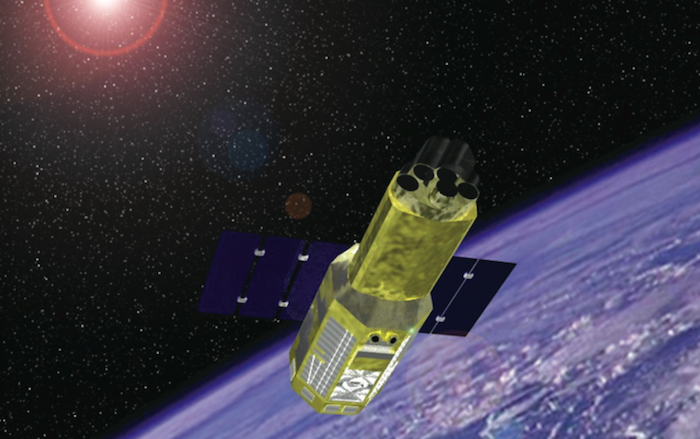.

Artist’s concept of the Suzaku satellite. Credit: NASA/JAXA
An orbiting astronomical observatory launched 10 years ago to probe violent stellar explosions and black holes has been deactivated after it stopped regularly communicating with the ground, the Japanese space agency said Thursday.
The Suzaku satellite spent a decade watching some of the most energetic parts of the cosmos, focusing on supernova explosions, black holes and galactic clusters, while peering back in time to study the structure of the universe billions of years ago.
Suzaku launched on a Japanese M-5 rocket on July 10, 2005, replacing a similar craft lost in a launch failure in 2000. The spacecraft was originally called Astro-E2, but Japanese officials renamed it Suzaku after a legendary red bird from Chinese mythology.
The mission — a joint project between NASA and the Japan Aerospace Exploration Agency — was supposed to last about two years but exceeded a decade of operations.
JAXA announced Aug. 26 it was ending the Suzaku mission, and ground controllers sent the final commands to disconnect Suzaku’s batteries from the satellite’s electrical circuitry Wednesday, a final step to reduce the chances of an explosion that could create space debris.
JAXA reported Suzaku is orbiting about 550 kilometers, or 341 miles, above Earth. At that altitude, experts predict the satellite will fall back into Earth’s atmosphere for an uncontrolled re-entry no earlier than 2020.
“Its communication with the ground had been established only intermittently since June 1, 2015, and JAXA had been trying to restore it,” the space agency said Aug. 26. “In addition to communication, JAXA has also examined the condition of the Suzaku’s batteries and attitude control, and concluded that it is difficult to resume its scientific observations.”
Suzaku was Japan’s fifth X-ray astronomy satellite, and it carried an X-ray spectrometer and cameras built in the United States and Japan.
The NASA-built X-ray spectrometer failed about one month into Suzaku’s mission after prematurely exhausting its supply of liquid helium coolant, which it needed to sense the faint heat of photons from faraway X-ray light sources.
U.S. scientists also provided four X-ray telescopes to focus light on Suzaku’s Japanese-built cameras, which continued functioning throughout the mission.
Suzaku also hosted a detector devoted to measuring high-energy X-rays with more sensitivity than any mission before.
“While it continued its observations by exceeding its target life, JAXA had to exercise wisdom to find the best use of the deteriorating batteries in recent years,” JAXA said in a statement. “Suzaku’s around 10 years of observations achieved important scientific accomplishments in the field of structure formation in the universe and probing the very close region of a black hole.”
In a supernova remnant known as the Jellyfish Nebula, Suzaku detected X-rays from fully ionized silicon and sulfur — an imprint of higher-temperature conditions immediately following the star’s explosion. The nebula is about 65 light-years across.
Credit: JAXA/NASA/Suzaku, Tom Bash and John Fox/Adam Block/NOAO/AURA/NSF
Astronomers must send X-ray telescopes into space to study the high-energy universe. Earth’s atmosphere absorbs X-ray emissions, preventing such observations from the ground.
Suzaku’s accomplishments include research into the composition of fireballs left behind by supernova explosions. Astronomers using Suzaku also estimated there have been several hundred million “Type II” supernovas — the violent explosions of aging, massive stars — in the Milky Way galaxy since its formation, according to NASA.
“Using Suzaku data scientists determined there was a period about 10 billion years ago when heavy elements, including iron, were spread throughout the universe,” officials wrote in a mission overview posted on NASA’s website.
Japan is finishing up work on a new X-ray telescope called Astro-H for launch in early 2016.
Quelle: SN
4122 Views
